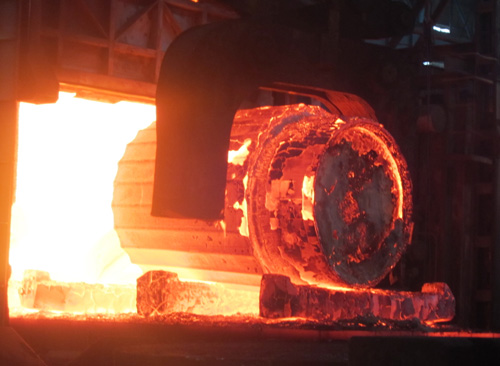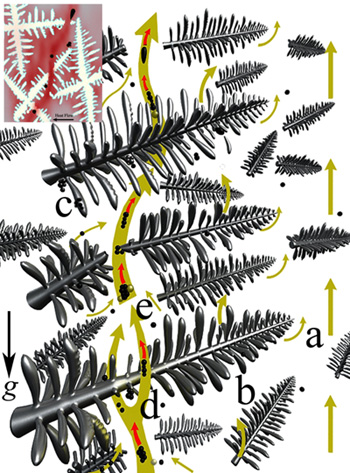On November 25th 2014,the international renowned journal Natural Communications has published the recent progress of the formation mechanism of macrosegregation in steels during the solidification conducted by the research team of Professors LI Dianzhong and LI Yiyi in the Shenyang National Laboratory for Materials Science, Institute of Metal Research (Nature Communications. 5:5572 doi: 10.1038/ncomms6572 (2014)). Through dissecting 100-ton cast steel ingots in combination with multi-scale simulations, they have discovered that the channel segregation in the widely used steels, which is the most difficult defects to be eliminated, originates from the flotation of the light oxide-based inclusions. This mechanism is intrinsically different from the theory already documented in the textbooks that the channel segregation is mainly driven by the natural thermalsolutal convection. The results demonstrated that the flotation of inclusion with appropriate size and population induces the destabilization of mushy zone and dominates the subsequent formation of channel segregation. Based on this mechanism, they found that the channel segregation can be significantly reduced or even eliminated in the huge ingots via the upstream low-oxygen purifying metallurgy.
It is well-known that macrosegregation is one of the most severe defects in materials. It was found for more than one thousand years, but until the 1960s, the fundamental theory was established. The principal mechanism of this theory attributed the occurrence of the macrosegregation to the natural convection of melt. Within the framework of this classical theory, it is generally acceptable that the macrosegregation in steels can be attributed to the solute and impurity elements, such as C, Si, Mn, S, P and so on. Therefore, since then the technologies to control the macrosegregation was developed by mainly controlling the melt flow. However, in the industrial practices, this underlying mechanism remains controversial and such techniques are usually not efficient to inhibit the occurrence of macrosegregation in heavy ingots. This study uncovered a mystery of oxygen in steels, extends the classical macro-segregation theory, and highlights a significant breakthrough to control the channel segregations through low oxygen purifying technologies.
Nature Publishing Group highlighted this work in its platform of Press Releases, titled as “Steel production: Towards a perfect cast” as following,
“A mechanism responsible for the degradation of steels during casting is reported this week in Nature Communications. The discovery may lead to changes in steel manufacture that could result in practical improvements to the 50 million tons of ingots, heavy plates and castings produced annually.
Steels are alloys made from a range of different elements. A major fabrication issue causing early failure is the nonuniform distribution, or segregation, of these elements in the material during solidification. Whilst some causes for segregation are known, for example convection during the casting process, it remains an issue for steel manufacturing and the full explanation behind its occurrence is unclear.
Prof. LI Dianzhong and his colleagues have now uncovered a mechanism where impurities based on compounds formed by oxygen and lighter metals create a material flow that drives compositional variation during casting. In experiments using large steel casts of up to 650 tons in weight, segregation could be avoided by reducing the amount of oxygen in the steel. Controlling oxygen concentration could therefore be a promising method to improve the quality of steels produced in the future.”

Figure 1, Casting 100-ton ingot

Figure 2, The heat treatment of the 100-ton casting ingot

Figure 3, Schematic of inclusion flotation among the inter-dendritic regions